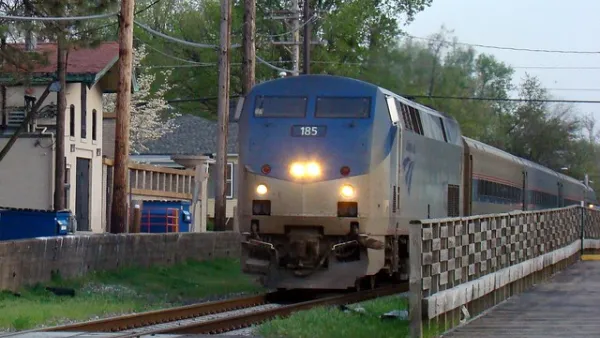The speedometer on the Chicago to St. Louis train hit 110 mph - and stayed there for five minutes, but it was enough to elevate the spirits of Transportation Secretary Ray LaHood and the other dignitaries on-board. Normal speeds top out at 79 mph.
The Associate Press' Jason Keyser reports on a symbolic Oct. 19 Amtrak ride that served as a morale-lifter for the Midwest's high speed rail advocates. The higher speed of 110 mph will become the norm for most of the route by 2015. This was the first time that Amtrak traveled that fast on any Midwestern route. Due to shared trackage with freight trains, it is not expected that speeds will go surpass 110 mph.
While the Northeast Corridor has its high-speed Acela train (see Eric Jaffe's Oct. 19 article on the 5% increase in Amtrak ridership in September over last year in this corridor that includes the Northeast Regional train in the Atlantic Cities) and California has it's embattled San Francisco-Los Angeles project designed to reach 220 mph, the Midwest has not received as much attention as high speed rail on the coasts. In fact, most publicity arose due to the rejection of the high speed rail grants included in President Obama's 2009 Recovery Act (stimulus funding) by Ohio Gov. John Kasich and Wisconsin Governor Scott Walker.
"Four years ago we were nowhere. Illinois and the country was a wasteland when it came to high speed rail," said U.S. Transportation Secretary Ray LaHood. "This is a dream come true today." Also on-board was Illinois Gov. Pat Quinn and other politicians and transportation officials and rail advocates, including Richard Harnish, director of the Midwest High Speed Rail Association.
"The improved Amtrak service in the Chicago-St. Louis corridor signals a genuine commitment to faster, safer, and cleaner travel", stated Harnish.
Not all in Illinois are advocates of the higher speed train service though. Kristina Rasmussen, vice president of the llinois Policy Institute, expressed doubts about the line's ability to break-even due in part to political pressure to keep fares low.
"We're yoking ourselves to trains that will obligate taxpayers to provide billions of dollars in future subsidies," she said.
FULL STORY: Illinois Amtrak Train Set To Hit 110 Mph In Test Run

Analysis: Cybertruck Fatality Rate Far Exceeds That of Ford Pinto
The Tesla Cybertruck was recalled seven times last year.

National Parks Layoffs Will Cause Communities to Lose Billions
Thousands of essential park workers were laid off this week, just before the busy spring break season.

Retro-silient?: America’s First “Eco-burb,” The Woodlands Turns 50
A master-planned community north of Houston offers lessons on green infrastructure and resilient design, but falls short of its founder’s lofty affordability and walkability goals.

Test News Post 1
This is a summary

Analysis: Cybertruck Fatality Rate Far Exceeds That of Ford Pinto
The Tesla Cybertruck was recalled seven times last year.

Test News Headline 46
Test for the image on the front page.
Urban Design for Planners 1: Software Tools
This six-course series explores essential urban design concepts using open source software and equips planners with the tools they need to participate fully in the urban design process.
Planning for Universal Design
Learn the tools for implementing Universal Design in planning regulations.
EMC Planning Group, Inc.
Planetizen
Planetizen
Mpact (formerly Rail~Volution)
Great Falls Development Authority, Inc.
HUDs Office of Policy Development and Research
NYU Wagner Graduate School of Public Service


























